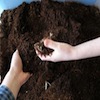Going Underground: Compost Pit or Trench Composting

Organic Compost From a Compost Pit
If you're thinking about starting a compost pile, there are several things to consider; what type of composting structure to use, where to put it, and what to do with the finished compost product. Fortunately, composting can happen just about anywhere, and getting started can literally be as simple as heaping waste in a pile or burying it in a hole. There are advantages (and disadvantages) to composting without a container aboveground or underground. This article will examine the pros and cons of simply burying your organic waste in the ground.
Start Digging: Compost Pit
Compost Pit, (or trench composting) is about as basic as it comes: dig a hole, throw in your organic waste, and cover it with soil. You're done!
Composting underground utilizes what is known as anaerobic decomposition to break down the organic matter. Anaerobic decomposition works without oxygen, so there is no need for turning or aerating the matter. Anaerobic decomposition works much slower than the aerobic process that takes place aboveground.
Advantages of a Compost Pit
Putting your compost underground has some distinct advantages over aboveground composting:
- It's cheap. Other than a shovel, there's really no other equipment needed.
- It's easy. Dig a hole, throw in the waste, cover it up. There's also no need to monitor the temperature or moisture levels or turn the material- EVER.
- It's 'invisible.' There are no compost piles or containers visible to you or your neighbors.
- It doesn't attract pests.
- It is good for disposing of a one-time large load of waste. (such as after a large party, fruit or vegetable canning waste, end-of-season garden or yard waste removal)
- It's great if you live in a community where aboveground composting isn't allowed.
- It allows you to improve the soil structure and fertility in a future garden bed.
A couple words of caution: If you bury your organic waste to compost underground, the anaerobic decomposition occurs slower, meaning it may take several months to a year before your waste breaks down into usable compost. Also, digging into an underground compost pit can be a stinky affair; unlike aboveground compost, the underground anaerobic critters doing the decomposing work emit stinky gases as a by-product of their hard work. Best that they be left alone to do their dirty work.
Where to Dig? You can dig your compost hole basically anywhere it will be convenient for you. Make sure you don't dig near underground utility lines. How big a hole you dig really depends on how much waste you need to compost.
If you're planning on using your finished compost product, remember that it won't be that easy to dig it up after you've buried it. If you garden, a great place to put your trench compost holes is between the rows of your garden. As the organic matter in the trenches rots, the nutrients become available for nearby plants.
Rotating trenches with planting areas each season will help develop healthy garden soil over time. Divide your garden space into 3 areas: a growing row for plants, a pathway row, and a row for trench composting. The following year, you can plant in the previous year's compost row. Doing this each growing season will improve the soil in the entire garden.
If you have the space available to you, and your ground isn't too hard to dig into , underground trench or pit composting can be an easy, viable method of composting for you.
Interested In More On Composting?
We offer a lot of information on composting and some great composting product reviews. If you really want to get your feet wet in the composting business, be sure to read these additional articles of interest:
Composting 101
Worm Composting
Vermiculture - A Worms Healthy Home
Vermicomposting - Troubleshooting Tips
Compost Pit
Compost Container
Making Compost
Soil Saver Classic Composter Product Review
GeoBin Composting Container Product Review
Worm Factory 360 Product Review



































































